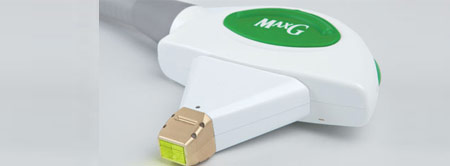While there are multiple options in the market for cosmetic laser treatment of skin ailments such as port wine stains, facial telangiectasia, rosacea, and poikiloderma, there is one technology that stands above the rest in terms of consumer satisfaction: Palomar’s MaxG. Essentially an arc lamp-based handpiece that functions as an optimzed pulsed light source, the MaxG features uniform, spike-free output power, dual-band spectral output, and dynamic spectral shifting. Each of these features allows the MaxG to treat vessels ranging in size and depth, making it a safe and efficient alternative to its less-exacting competitors.
Until recently, the standard approach to treatment of pigmented lesions and other skin ailments has involved a pulsed-dye laser, or PDL, which requires precise wavelength, energy, and pulse duration considerations. Use of a PDL has various drawbacks, however, including its inability to deliver smooth, long pulses. Instead, the required treatment includes a series of short pulses that can compromise skin safety and increase the risk of ablative damage. Additionally, the single, short wavelengths of a PDL offers limited penetration of larger vessels as well as vessels lying deeper in the dermis.
OPLs, or optimized pulsed light sources such as the MaxG, on the other hand, are able to bypass those concerns and provide a better skin result as well. Since the MaxG boasts uniform and spike-free output power, each pulse offers the same average power so there is increased control in output level and in what vessel is being targeted. That control is aided largely by MaxG’s selective energy absorption that is created by delivering light in two spectral bands: 500-670 nm and 870-1200 nm. The joint operation of these two bands in the MaxG helps to protect the skin surface during treatment along with the cooling function already embedded in the handpiece. Also, while PDLs struggle with coagulation, the MaxG easily achieves it in both large and deep-set blood vessels through providing less absorption and less scatter by way of deeper penetration. Finally, the Palomar MaxG handpiece is superior in its dynamic spectral shifting capability. Just as the vessels constructing vascular lesions vary in size and depth, the MaxG offers a dynamic spectral shift that activates when fluence and/or pulse width is changed, resulting in a superior outcome.
As far as the treatment of skin ailments goes, the MaxG is a superior product that offers better overall results for pigmented and vascular lesions. In patient trials, the MaxG performed far more reliably and efficiently than an alternative PDL device, requiring only one to two treatment periods per ailment. For example, marked improvement was seen in a patient with facial telangiectasia after just one treatment and another patient with poikiloderma had 90% skin improvement after just one treatment as well. Specifically with regard to patient satisfaction, then, and considering the broader capabilities of an OPL, the MaxG’s optimized pulsed light source approach is far superior to the former “go to” PDL treatment option.
